July 19, 2023 feature
This article has been reviewed according to Science X's editorial process and policies. Editors have highlighted the following attributes while ensuring the content's credibility:
fact-checked
peer-reviewed publication
trusted source
proofread
Dynamics of molecular rotors in bulk superfluid helium
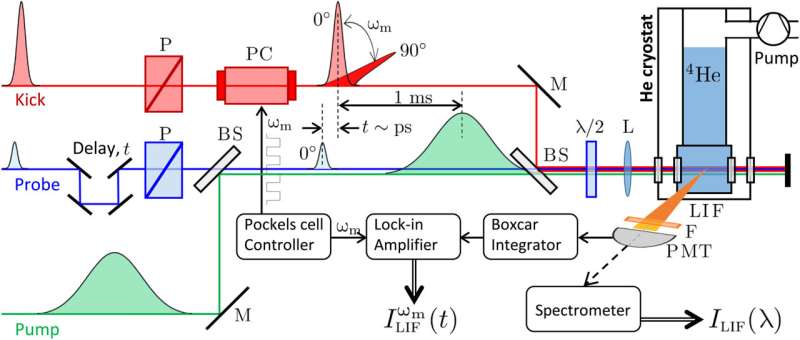
Molecules immersed in liquid helium can probe superfluidity since their electronic, vibrational and rotational dynamics can provide valuable cues about the superfluid at the nanoscale. In a new report in Science Advances, Alexander Milner and a team of scientists in physics and astronomy, and chemistry at the University of British Columbia, Canada and the University of California, Irvine, U.S., described an experimental study of laser-induced rotation of helium dimers inside a superfluid helium bath at various temperatures.
The team regulated the coherent rotational dynamics of helium with ultrashort laser pulses tracked via time-resolved laser-induced fluorescence. The research outcomes offered a new path to study superfluidity with molecular nanoprobes under a variety of thermodynamic conditions.
Liquid helium
The superfluid phase of liquid helium (LHe) denoted He II forms a strongly interacting quantum system with unique physical properties giving rise to several questions of its composition. Primary among them is the microscopic interpretation of an intrinsically macroscopic two-fluid model of superfluidity that describes the system in two forms: a normal fluid behaving like a classical liquid and a superfluid with zero viscosity that flows without resistance.
Landau's theory demonstrates the normal component to contain collective elementary excitations including phonons and rotons with corresponding dispersion and scattering behaviors that govern the function of the entire system. The two-fluid model predicted the process of second sound—a temperature wave that moved through the liquid via periodic exchange of normal and superfluid fractions.
Helium excimers
Elementary excitations in superfluid helium can be studied with neutron scattering and by observing the dynamics of embedded atoms and molecules. To examine the inherently macroscopic two-fluid model of helium II, the researchers carried out measurements as a function of thermodynamic variables, accomplished using helium dimers known as excimers (He2*)—the native molecular probe of liquid helium.
Helium excimers have a lifetime on the order of seconds, and are ideally suited for time-resolved quantum environment probing. Milner and colleagues presented a time-domain study to prepare coherent rotational wave packets in helium excimers and explored their decoherence with femtosecond resolution in a superfluid quantum bath, at varied temperatures. The scientists produced a-state excimers using intense pump pulses to excite molecular rotation via a linearly polarized femtosecond "kick" pulse to follow-through with a delayed probe pulse, for direct measurements.
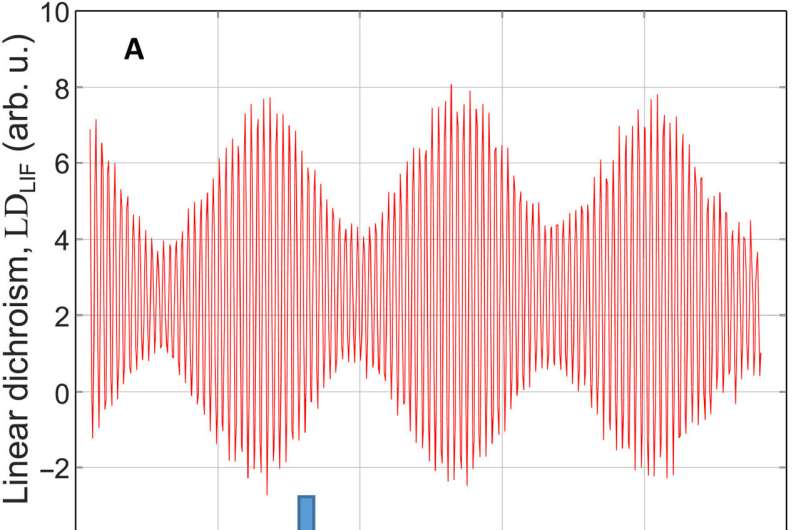
The experiments
The team presented the signals as a function of the kick-probe delay. Unlike vibrational excitations, transition of rotational population from the ground to the excited state required two-photon Raman frequencies within the bandwidth of the kick pulses.
The team explored if the linear dichroism lines originated from rotationally hot molecules created by the pump pulse that had not decayed to the ground rotational state, or if they stemmed from molecules coherently excited by the kick pulse; the outcomes highlighted the influence of the kick pulse.
The molecular dynamics of bulk liquid helium
The team further conducted numerical calculations of the expected ratio between the two linear dichroism peaks by solving the Schrödinger equation. The team then plotted the ratio of the two linear dichroism peaks calculated for the experimentally used kick energies. The outcomes showed how many helium dimers relaxed to the ground rotational state about a millisecond after creation by a pump pulse, with a shorter rotational decay constant. The team further verified the conclusion by numerically modeling the expected signal.
A primary advantage of studying molecular dynamics in bulk liquid helium is the potential to vary the pressure and temperature of the superfluid by probing the macroscopic nature of superfluidity. A clear decrease of liquid dichroism with temperature increasing towards the lambda point provided a signature of the interaction between the liquid and laser-induced coherent rotation of helium dimers. The team conducted the experiments in a custom-built cryostat and incorporated three laser pulses: pump, kick and probe delivered to the cryostat focused in liquid helium.
-
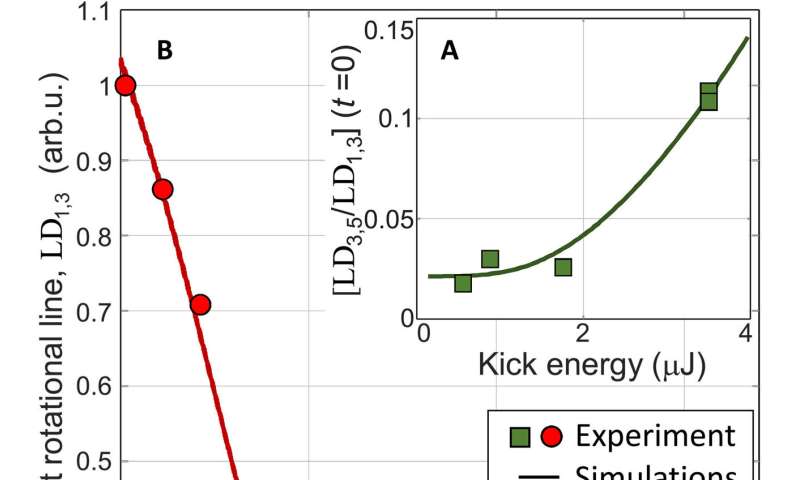
Time and energy dependence of LD. (A) Amplitude ratio of the two rotational lines in the LD spectrum, LD3,5 and LD1,3, as a function of the kick pulse energy (green squares) at T = 1.35 K. (B) Long-time amplitude dependence of the first rotational peak at T = 1.95 K, normalized to LD1,3(t = 0) (red circles). In both panels, solid lines represent the results of numerical simulations. Credit: Science Advances (2023). DOI: 10.1126/sciadv.adi2455 -
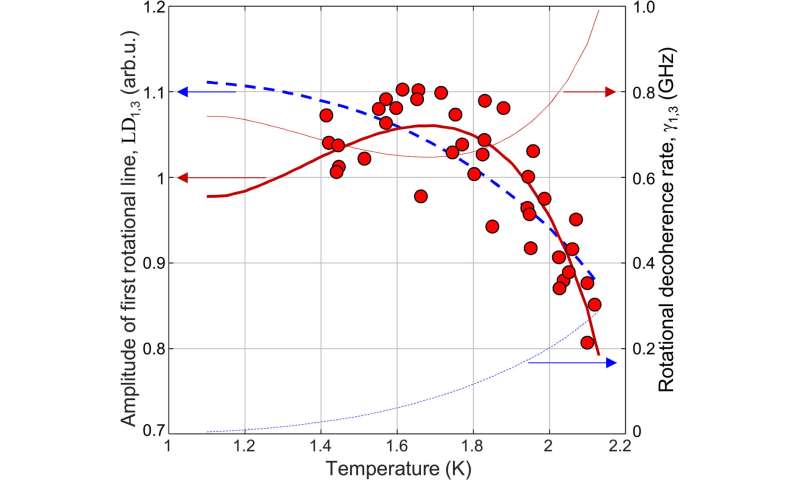
Temperature dependence of LD. Dependence of the amplitude of the first rotational peak (LD1,3) on the temperature of the superfluid at the kick-probe delay of t = 850 ps (red circles, left vertical axis). Thick blue dashed and red solid lines are fits to the equilibrium kinematic decoherence model and its nonequilibrium modification, respectively. Thin blue dashed and red solid lines are corresponding decoherence rates (right vertical axis). Credit: Science Advances (2023). DOI: 10.1126/sciadv.adi2455 -
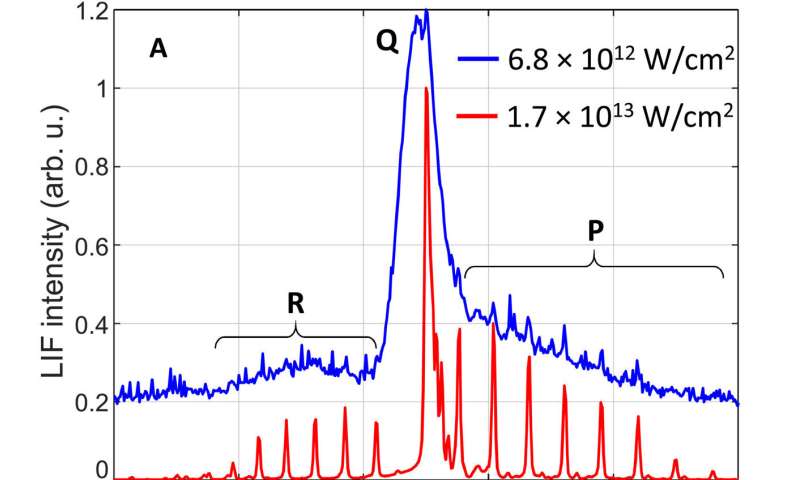
Laser induced-fluorescence (LIF) from metastable helium dimers. (A) Pump-induced d → b fluorescence spectrum of He∗2 at T = 2 K with P, Q, and R rotational branches labeled. The broadening of rotational lines with decreasing pump intensity demonstrates the transition between the molecules in macroscopic gas pockets ("gas phase," lower red line) and solvated molecules (bubble phase, upper blue line) and illustrates the effect of the superfluid on the molecular rotation. (B) Intensity of the probe-induced fluorescence as a function of temperature (dots) and its fit to the expected bimolecular decay. Credit: Science Advances (2023). DOI: 10.1126/sciadv.adi2455
Outlook
In this way, Alexander Milner and colleagues conducted a first study on the experimental observations of laser-induced coherent molecular rotation in bulk superfluid liquid helium. They did not credit the observed rotational decoherence of helium excimers to biomolecular collisions. Using time-resolved methods, they detected and studied a variety of rotational dynamics across three windows of time, where they characterized the degree of rotational cooling, probed the spin-spin dynamics and investigated the decay of rotational decoherence at the nanoscale.
The outcomes of the rotational relaxation of liquid helium can improve the process of laser-induced fluorescence-based molecular tagging methods to understand studies of counterflow and quantum turbulence, by examining microscopic implications of superfluidity with molecular nanoprobes.
More information: Alexander A. Milner et al, Dynamics of molecular rotors in bulk superfluid helium, Science Advances (2023). DOI: 10.1126/sciadv.adi2455
Wei Guo et al, Visualization of two-fluid flows of superfluid helium-4, Proceedings of the National Academy of Sciences (2014). DOI: 10.1073/pnas.1312546111
Journal information: Proceedings of the National Academy of Sciences , Science Advances
© 2023 Science X Network





















